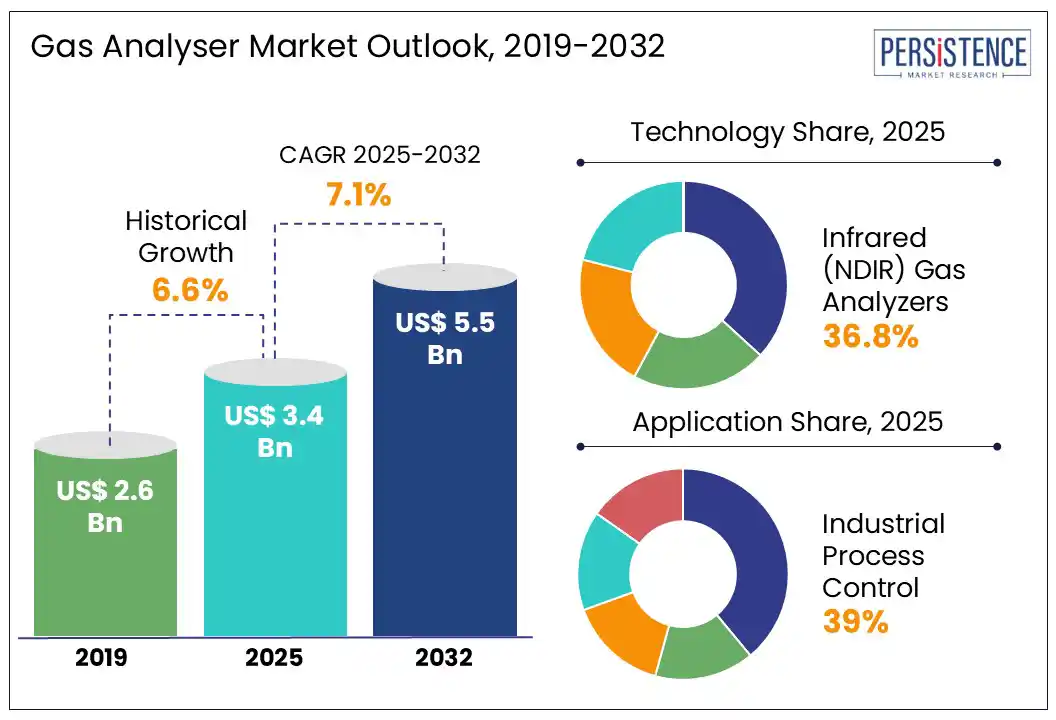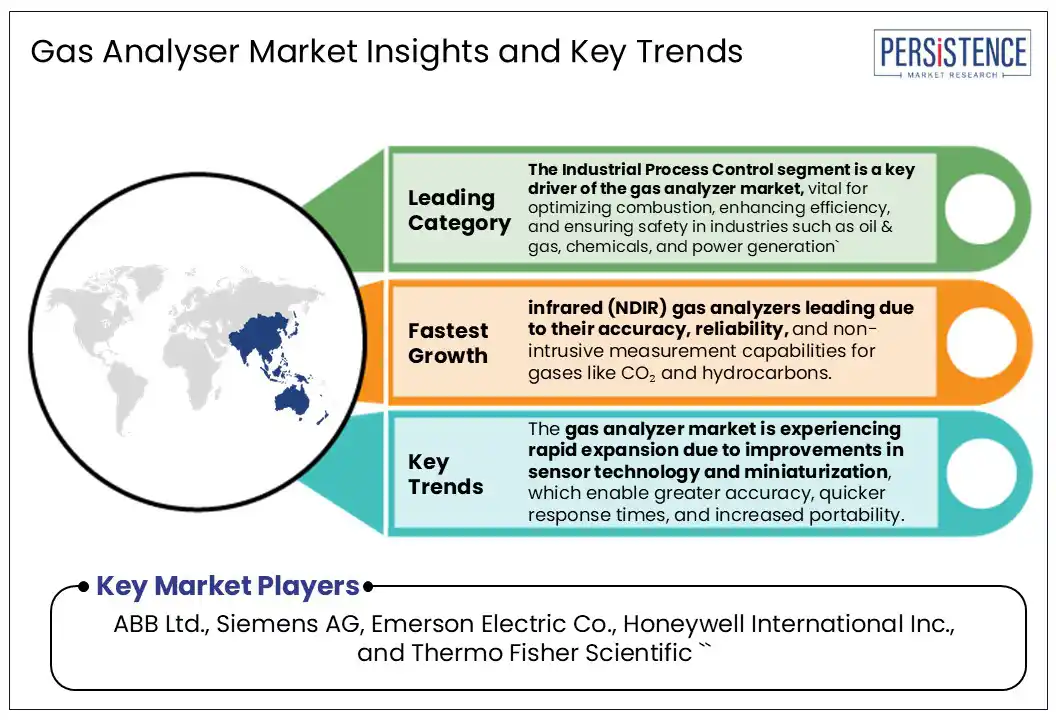ID: PMRREP35473| 193 Pages | 9 Jul 2025 | Format: PDF, Excel, PPT* | Industrial Automation

The Global Gas Analyzer Market size is likely to be valued at US$ 3.4 Bn in 2025 and is expected to reach US$ 5.5 Bn in 2032 with a staggering CAGR of 7.1% during the forecast period from 2025 to 2032.
Gas analyzers quickly and accurately determine gas concentrations in mixtures and are highly versatile. Equipped with state-of-the-art sensors and intuitive controls, these analyzers are easy to operate, ensuring precise analysis results and maintaining the quality of various processes. Depending on the application, gas analyzers can be provided either as standalone units or integrated into gas mixing systems.
Available as either stationary or portable devices, they can be used for sampling or continuous gas analysis across a wide range of technical gases and applications. Witt offers gas analyzers for gases such as oxygen, carbon dioxide, helium, hydrogen, and methane. These analyzers are utilized in various sectors, including food and pharmaceutical industries, hospitals, and medical applications, and play a crucial role in managing gas supply lines in thermal processing plants, among other industrial applications. Additionally, Witt provides specialized versions of these gas analyzers for monitoring indoor air quality.

Key Industry Highlights:
|
Global Market Attribute |
Key Insights |
|
Gas Analyzer Market Size (2025E) |
US$ 3.4 Bn |
|
Market Value Forecast (2032F) |
US$ 5.5 Bn |
|
Projected Growth (CAGR 2025 to 2032) |
7.1% |
|
Historical Market Growth (CAGR 2019 to 2024) |
6.6% |
The increasing focus on process optimization and predictive maintenance is a significant factor driving the Gas Analyzer Market. Sectors like oil & gas, chemicals, and manufacturing are incorporating real-time gas analysis to improve operational efficiency and lessen downtime. Gas analyzers play a crucial role in identifying early indicators of equipment failure by continuously monitoring emissions and gas composition, which enables proactive maintenance and reduces the likelihood of unexpected breakdowns.
Furthermore, gas analyzers equipped with IoT technology allow for remote monitoring, enhancing safety and ensuring compliance with regulations. As industries place greater importance on automation and efficiency, there is a growing demand for sophisticated gas analyzers that feature smart sensing capabilities.
In March 2024, ABB Ltd. launched the GasSense 3000, a portable dissolved gas analyzer intended for use by field engineers. This instrument allows for quick and precise on-site analysis of transformer oil, enabling immediate diagnostics and minimizing operational downtime. By combining real-time gas analysis with predictive maintenance approaches, the GasSense 3000 illustrates how advanced gas analyzers improve operational efficiency and equipment reliability in industrial environments.
Gas analyzers are sensitive to environmental conditions such as temperature, humidity, and pressure, which can affect their accuracy and performance. Extreme temperatures may cause sensor drift, while high humidity can lead to condensation that impacts responsiveness and longevity. Pressure variations can alter gas concentrations, resulting in incorrect measurements. These issues are crucial in precision-demanding industries such as healthcare and environmental monitoring.
To address these challenges, frequent recalibration and environmental compensation mechanisms are needed, increasing complexity and maintenance costs. Metal-oxide-semiconductor (MOS) sensors, used for gases like carbon monoxide and ammonia, are particularly prone to cross-sensitivity due to humidity, resulting in inaccurate readings. Fluctuations in temperature and humidity also contribute to calibration drift, necessitating regular recalibration.s
The gas analyzer market is experiencing rapid expansion due to improvements in sensor technology and miniaturization, which enable greater accuracy, quicker response times, and increased portability. Developments such as tunable diode laser absorption spectroscopy (TDLAS), photoacoustic spectroscopy (PAS), and non-dispersive infrared (NDIR) sensors are enhancing the precision of gas detection. Furthermore, MEMS-based electrochemical sensors provide compact, economical options with low energy consumption.
The creation of wireless, IoT-enabled gas analyzers facilitates real-time remote monitoring and predictive analytics, contributing to their increased use in industrial safety, environmental monitoring, emergency response, and field operations, thereby propelling market growth.
In March 2024, Gasera Ltd. launched the GASERA ONE PULSE+, a cutting-edge gas analyzer that showcases advancements in sensor technology and miniaturization. This analyzer employs Gasera's patented photoacoustic spectroscopy technology and can achieve detection levels as low as parts-per-billion (ppb). Its improved sensitivity, stability, and versatility make it ideal for a broad array of challenging gas monitoring applications.
The application segment is anticipated to experience a remarkable CAGR of 7.5% during the forecast period. The Industrial Process Control segment is a key driver of the gas analyzer market, vital for optimizing combustion, enhancing efficiency, and ensuring safety in industries such as oil & gas, chemicals, and power generation. Gas analyzers regulate air-to-fuel ratios, reducing emissions and energy consumption while ensuring compliance with strict environmental regulations. In chemical processing, they prevent hazardous leaks and stabilize processes. Real-time gas analysis supports predictive maintenance, minimizing downtime. The growing adoption of automated and IoT-enabled analyzers boosts demand for optimization and safety.
In March 2023, ABB implemented its advanced gas analyzers in a Middle Eastern oil refinery, optimizing air-to-fuel ratios and achieving a 10% reduction in fuel consumption and a 15% cut in NOx and CO emissions, while enhancing safety and compliance. This highlights how industrial process control fuels market growth by improving efficiency and safety in heavy industries.
Infrared (NDIR) gas analyzers are leading due to their accuracy, reliability, and non-intrusive measurement capabilities for gases such as CO? and hydrocarbons. They are essential in environmental monitoring, industrial process control, and emissions monitoring, allowing for real-time gas detection with minimal maintenance. Key industries such as power generation and oil & gas rely on NDIR analyzers to optimize combustion efficiency and comply with air quality regulations. Their durability and resistance to sensor poisoning further enhance demand.
In October 2024, ELT Sensor Corp. showcased its Non-Dispersive Infrared (NDIR) gas sensors at the SEDEX Semiconductor Exhibition and the Korea Society for Atmospheric Environment conference. These sensors monitor greenhouse gases and air quality in industrial settings, such as semiconductor manufacturing and chemical plants. By delivering accurate, real-time measurements of gases such as CO and methane, ELT Sensor's technology helps improve efficiency, ensure regulatory compliance, and enhance workplace safety, highlighting the importance of NDIR gas analyzers in modern industrial processes.

The booming petrochemical and refining industry in Asia Pacific is a key driver for the gas analyzer market's dominance in the region. Countries like China, India, and South Korea are home to some of the world's largest oil refineries and petrochemical complexes, leading to a high demand for gas analyzers in process control, emissions control system, and safety compliance. Strict environmental regulations on air pollution and hazardous emissions further accelerate adoption. Additionally, the region’s rapid industrialization, growing energy consumption, and increasing investments in refining capacity expansions create a sustained demand for advanced gas analysis technologies, solidifying Asia Pacific’s market leadership.
Sinopec has completed the second-phase expansion of its Zhenhai Refinery in Zhejiang, China, increasing its capacity to 40 million tonnes per year and establishing it as the country’s largest petrochemical industrial base. With an annual ethylene production capacity of 2.2 million tonnes, the refinery is set to be a key player in the Yangtze River Delta’s economy, crucial for downstream product consumption. The expansion, which cost approximately 41.6 billion yuan (around $5.69 billion), includes 18 production units and aims to produce high-end polyolefins and specialty chemicals, contributing around eight million tonnes of petrochemical products annually to vital sectors like automotive and textiles.
The gas analyzer market in Europe is driven by strict environmental regulations and emission monitoring policies from the European Union (EU), such as the Industrial Emissions Directive and the Ambient Air Quality Directive. These regulations require industries, especially in power generation, oil & gas, and manufacturing, to monitor emissions to comply with environmental standards. Europe's commitment to sustainability and pollution control, highlighted by the European Green Deal aimed at carbon neutrality by 2050, further stimulates market growth.
Europe's position in the gas analyzer sector is the European Green Deal, which aspires to achieve carbon neutrality by 2050. As part of this effort, the EU's Industrial Emissions Directive (IED) requires continuous emissions monitoring for sectors such as power generation and refining. For example, Germany's coal-fired power generation facilities must implement Continuous Emission Monitoring Systems (CEMS), which utilize sophisticated gas analyzers to track pollutants such as CO, SO, and NOx in real-time. This rigorous regulatory environment drives industries to invest in highly accurate gas analyzers, reinforcing Europe's leadership in the market.
The increasing demand for clean energy and the hydrogen economy is driving the gas analyzer market in North America, with the U.S. and Canada investing heavily in hydrogen production, fuel cells, and carbon capture technologies. Gas analyzers are essential for monitoring hydrogen purity and detecting contaminants, ensuring production and storage efficiency. Carbon capture and storage (CCS) initiatives also require advanced gas analyzers to measure CO emissions.
North America's leadership in the gas analyzer market is exemplified by the U.S. Department of Energy's Hydrogen Hub Initiative, which has allocated US$7 billion under the Bipartisan Infrastructure Law to develop regional hydrogen hubs. These hubs focus on hydrogen production, storage, and utilization, requiring high-precision gas analyzers to monitor purity and detect contaminants. This significant investment drives the demand for advanced gas analyzers in the region.
The gas analyzer market is highly competitive, with major players concentrating on technological progress, product innovation, and strategic alliances to enhance their market presence. Prominent companies lead the sector by providing sophisticated gas-sensing solutions for a variety of applications. These companies heavily invest in research and development to improve sensor precision, compactness, and compatibility with IoT and AI-driven analytics.
Newly emerging companies and startups are entering the marketplace with affordable and portable gas analyzers, increasing competition. Mergers, acquisitions, and partnerships are influencing the industry, as companies broaden their geographical reach and expand their product lines. The market is also witnessing a rising demand for cloud-based monitoring and predictive maintenance services. However, challenges such as substantial initial investments and compliance with regulations pose barriers to entry for newcomers. Ultimately, trends in innovation and sustainability will shape the competitive landscape of the gas analyzer market.
The Gas Analyzer market is estimated to be valued at US$ 3.4 Bn in 2025.
Increasing demand for process optimization and predictive maintenance in industrial sectors is the key demand driver for the Gas Analyzer market.
In 2025, Asia Pacific dominates the market with ~35.6% share in the global Gas Analyzer market.
Among Technologies, preference for Infrared (NDIR) Gas Analyzers segment is expected to grow rapidly at 8.1% CAGR from 2025 to 2032.
ABB Ltd., Siemens AG, Emerson Electric Co., Honeywell International Inc., and Thermo Fisher Scientific are the leading players in Gas Analyzer market.
|
Report Attribute |
Details |
|
Historical Data/Actuals |
2019 - 2024 |
|
Forecast Period |
2025 - 2032 |
|
Units |
Value: US$ Bn, Volume: Units |
|
Geographical Coverage |
|
|
Segmental Coverage |
|
|
Competitive Analysis |
|
|
Report Highlights |
|
|
Customization and Pricing |
Available upon request |
By Product type
By Gas Type
By Technology
By Application
By End-user
By Region
Delivery Timelines
For more information on this report and its delivery timelines please get in touch with our sales team.
About Author